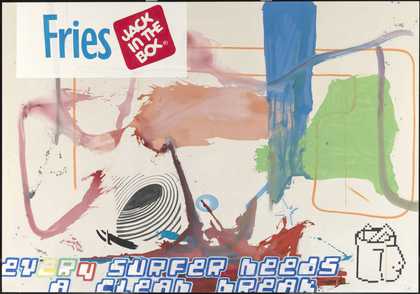
Michel Majerus
Fries (2001)
Tate
© The estate of Michel Majerus, courtesy neugerriemschneider, Berlin
Pop Reloaded is the fifth Project Space at Tate Liverpool and presents work by Michel Majerus.
Born in Esch, in Luxembourg in 1967, Michel Majerus was a key figure amongst a new generation of painters, and was included in a number of important group exhibitions in Europe and the US. Majerus lived and worked in Berlin until his death in an accident in November 2002.
Painting was Majerus’s preferred medium of expression, but his creative horizon extended to many aspects of popular culture, from computer games, digital imagery, film, television, and pop music to trademarks and corporate logos. His work also displayed an appreciation of the history of painting in the twentieth century, with references to work by artists such as Willem de Kooning, Cy Twombly, Gerhard Richter, Frank Stella and James Rosenquist, as well as the master of Pop art, Andy Warhol.
During a prolonged sojourn in Los Angeles in 2001, Majerus began work on an ambitious series of large-format paintings. Completed in Berlin the following year, the series eventually comprised of over thirty works. Pop Reloaded includes a selection of nine canvases from these so-called LA paintings, as well as a short animated video, all of which are on show for the first time in the UK at Tate Liverpool.
Los Angeles’ striking blend of styles, materials and textures makes up a confusing visual landscape, which found its way indirectly into Majerus’s work. The monumental scale of the LA paintings reflects the gigantic billboards lining the freeways as well as referring to the formless scale of the urban conglomerate itself.
Whilst the series is named after the city where it was begun, the title also refers to the exaggerated artificiality and superficiality associated with California, and Los Angeles in particular – a kind of parallel universe in which a fabricated media world exists as credible alternative to what is otherwise commonly perceived as ‘reality.’ For example, xxx 2001 features a diagrammatic representation of a video cassette (an electronic storage medium now near-obsolete) that alludes to the ‘dream’ factory of Hollywood as well as the multi-billion dollar shadow industry of pornography.
As a group, the paintings provide a structured narrative that is not unlike the action sequence in Hollywood film, the ascending levels of a computer game or the composition of a pop song. Car chases are interrupted by adverts, followed by blank screens, which then suddenly burst with the loud graphic advertisement of the latest special offer. The works can be shuffled around to result in changing meanings, like the media images and impressions that are constantly remixed and combined in our minds.
Pop art’s fascination for the products of popular culture can be seen in works like splash bombs 2001, which draws us into a vertiginous graphic swirl of washing powder packaging. net2-die cast 2001 cut and pastes an image of a fighter jet and action figure into flat space. fries 2001 layers blown-up watercolour splashes, a black and white Op art logo, an outdated pixelated computer icon, a slogan in retro computer lettering, and the American brand logo ‘Jack in the Box’.
In his paintings Majerus pays homage to some of the masters of recent art history. splash 2001 inscribes a trade logo onto a dull surface of dark and light grey, and evokes many associations with other artworks: the late leaden landscapes of Mark Rothko (disrespectfully turned by ninety degrees); Cy Twombly’s automatic writing on monochrome grey; Gerhard Richter’s calculatedly uniform canvases, devoid of any individuality and emotional investment; Ed Ruscha’s high-concept, exquisitely textural calligraphy; and, perhaps, allusions to David Hockney’s iconic painting A Bigger Splash 1967, drained of all its rich sun and colour?
The paintings are complemented by a short animated video of Majerus’s constantly changing and morphing signature, illustrating his creative interaction with the music and club scene. At the same time, the video plays with the idea of celebrity as recognisable identity, in the shape of a graphic emblem that is constantly transformed and obscured.
Majerus often extended the presentation of his paintings into ambitious installations that radically changed the physical and mental experience of the gallery space. Early discussions for his exhibition at Tate Liverpool, for example, included an idea for a coloured plastic floor, to transform the space through relatively simple and, in essence ‘painterly’, means. And whilst deeply steeped in global media culture, Majerus also responded to local situations, integrating, for example, an image of Liverpool pop group Atomic Kitten in his initial ideas for the installation here.
The monumental series of LA Paintings are some of Majerus’s most impressive and complex works. They create a powerful environment in the gallery, and provide a fitting tribute to the artist.
Majerus came to international attention during the late 1990s, with exhibitions at the Kunsthalle, Basel in 1996; Manifesta 2 in 1998; Colour Me Blind! in Stuttgart, Münster and Dundee, and the German Open, Wolfsburg, both in 1999. Also in 1999, he created a major work which was presented on the façade of the Italian Pavilion at the Venice Biennale. He also exhibited at the Kunstverein in Cologne in 2001. Recent solo exhibitions include: neugerriemschneider, Berlin; Asprey Jacques, London; Friedrich Petzel Gallery, New York, and most recentlyat Hamburger Bahnhof, Museum of Contemporary Art in Berlin. Majerus was working on Project Space for Tate Liverpool when he died.
